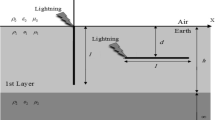Abstract
In this paper, impact of the causality of frequency-dependent models of soil on the effective area of grounding grids buried in single and two-layer soils is studied. In the analyses, the computationally efficient multi-conductor transmission line method is used. The simulation results show that the causality plays an important role on the effective area so that it can decrease or increase the effective area in comparison with the non-causal model. This reduction or increase depends on the low-frequency resistivity of dispersive soil and current waveform. The relative error due to non-causality is considerable only for the subsequent stroke current, whereas for the first stroke current, it is low enough to be ignored. In addition, the burial depth effect on the effective area in causal and non-causal-dispersive soils is investigated. With the aim of more accurate design, comprehensively predicting formulae for effective area versus low-frequency resistivity of soil, burial depth and current waveform under causal assumption are proposed. Finally, importance of effective area based on causal and non-causal models on the lightning-induced voltage on the soil surface is investigated.










Similar content being viewed by others
References
Grcev L (2009) Impulse efficiency of ground electrodes. IEEE Trans Power Del 24(1):441–451
Sajjadi SS, Aghajani V, Ostadzadeh SR (2019) Transient analyses of grounding electrodes considering ionization and dispersion aspects of soils simultaneously: an improved multiconductor transmission line model (improved MTL). Appl Comput Electromagn Soc J 34(5):731–737
Scott JH, Carroll RD, Cunningham DR (1964) Dielectric constant and electrical conductivity of moist rock from laboratory measurements. Sensor and Simulation Note 116, Kirtland AFB, NM
Smith KS, Longmire CL (1975) A universal impedance for soils. Defense Nuclear Agency, Alexandria, VA, USA, Topical Report for Period Jul. 1 1975–Sep. 30 1975
Messier M (1985) Another soil conductivity model. Internal rep., JAYCOR, Santa Barbara, CA
Visacro FS, Portela CM (1987) Soil permittivity and conductivity behavior on frequency range of transient phenomena in electric power systems. Presented at the symposium on high voltage engineering, Braunschweig, Germany
Portela CM (1999) Measurement and modeling of soil electromagnetic behavior. In: Proceedings of IEEE international symposium on electromagnetic compatibility, vol. 2. pp 1004–1009
Visacro S, Alipio R (2012) Frequency dependence of soil parameters: experimental results, predicting formula and influence on the lightning response of grounding electrodes. IEEE Trans Electromagn Compat 27(2):927–935
Cavka D, Mora N, Rachidi F (2013) A comparison of frequency-dependence soil models: application to the analysis of grounding systems. IEEE Trans Electromagn Compat 56:177–187
Ramo S, Whinnery JR, Van Duzer T (1984) Fields and waves in communication electronics. Wiley, New York
Visacro S, Alipio R, Pereira C, Guimaraes M, Schroeder MO (2015) Lightning response of grounding grids: simulated and experimental results. IEEE Trans Electromagn Compat 57:121–127
Alipio R, Visacro S (2014) Modeling the frequency dependence of electrical parameters of soil. IEEE Trans Electromagn Compat 15(1):1163–1171
Jardines A, Guardado JL, Torres J, Chavez JJ, Hernandez M (2014) A Multiconductor transmission line model for grounding grid. Electr Power Energy Syst 60:24–33
Sajjadi SS, Ostadzadeh SR (2019) Lightning response of multi-port grounding grids buried in dispersive soils: an approximation versus full wave methods and experiment. Adv Electromagn 8(1):43–50
Chang CN, Lee CH (2006) Computation of ground resistances and assessments of ground grid safety at 161/23.9 kV indoor-type substation. IEEE Trans Power Del 21(3):873–878
Moradi M (2018) Analysis of transient performance of grounding system considering frequency-dependent soil parameters and ionization. IEEE Trans Electromagn Compat 5(2):1–13
Sajjadi SS, Aghajani V, Ostadzadeh SR (2020) Comprehensive formulae for effective length of multiple grounding electrodes considering different aspects of soils: simplified multiconductor transmission line-intelligent water drop approach. Int J Numer Model Electron Networks Devices Fields 33(4):1–19
Sajjadi SS, Ostadzadeh SR (2020) Predicting formulae for effective length of counterpoise wires buried in ionized, dispersive and inhomogeneous soils. COMPEL Int J Comput Math Electr Electron 39(6):1375–1391. https://doi.org/10.1108/COMPEL-08-2019-0327
Author information
Authors and Affiliations
Corresponding author
Additional information
Publisher's Note
Springer Nature remains neutral with regard to jurisdictional claims in published maps and institutional affiliations.
Rights and permissions
About this article
Cite this article
Ostadzadeh, S.R., Sajjadi, S.S. Effective area of grounding grids in frequency-variant soils: causality versus non-causality. Electr Eng 104, 2123–2131 (2022). https://doi.org/10.1007/s00202-021-01458-4
Received:
Accepted:
Published:
Issue Date:
DOI: https://doi.org/10.1007/s00202-021-01458-4




